House Front Yard Design Pictures
The best foundation plants are low-growing, evergreen shrubs with fantastic curb appeal. Foundation plants are ideal for planting along the front of the house. Their short height and evergreen foliage can complement your garden landscape and enhance your home. The right foundation plants are also ideal for corner planting or entrance planting.
Foundation plants can be low shrubs, dwarf trees, small conifer bushes, or ground cover plants. Using evergreen shrubs keeps the area around your home green throughout the year. Flowering garden plants add color in spring, summer, and fall. And small evergreen trees add visual appeal beside doorways or corners.
The article describes some of the best foundation plants to boost your home's visual appeal.
Why Grow Foundation Plants in the Front Yard
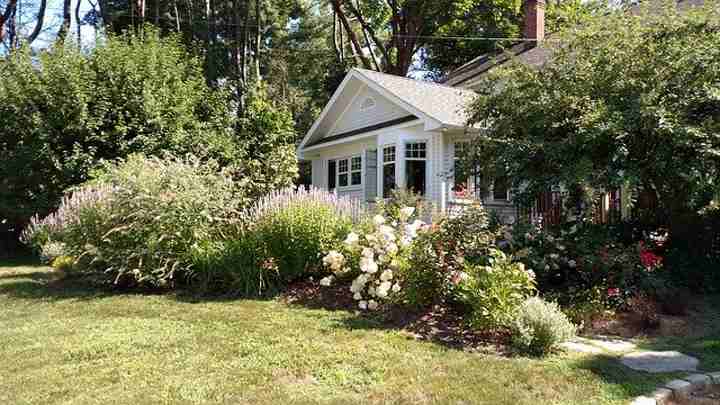
Foundation plants enhance the visual appeal of the house and hide its foundations
Growing foundation plants has many visible and practical benefits. The right types of low-growing shrubs hide the property's foundations, creating a natural transition from garden to the house. Choosing the right foundation plants makes your property more attractive and appealing and can even increase its value.
How to Choose Foundation Plants for the Front Yard

Low growing evergreen shrubs are great choice as landscaping plants for the front yard
Some excellent low maintenance shrubs such as boxwood, wintercreeper, rhododendrons, and holly are all suitable foundation plants. These short, evergreen bushy plants keep their foliage all year. The plants grow in sun or partial shade. They are drought-tolerant and don't grow too tall.
Low-growing shrubs that are attractive all year are excellent choices for foundation plantings. These shrubs are ideal because they won't block views from your window. Also, consider the amount of sun your front yard gets when choosing plants—some foundation plantings need full sun, whereas others grow better in the shade.
Drought-tolerant plants are also ideal for foundation planting. Letting the soil dry between watering helps to prevent dampness around your home. That is why it's a good idea to plant short shrubs 3 ft. (1 m) apart. Plenty of air circulation around plants near your foundation also helps keep damp away from your property.
Avoid shrubs or small trees that have invasive roots because they can affect the property's foundation. These larger shrubs should be planted at least 5 ft. (1.5 m) from your home.
Types of Foundation Plants – Excellent Landscaping Shrubs for Front of House
What are the best low-growing landscaping plants to grow along the front of your house? Let's look in detail at ideal foundation plants to beautify your garden and enhance your home's curb appeal.
Boxwood (Buxus) Shrubs for Foundation Plantings

Buxus microphylla 'Green Pillow' (in the picture) is a compact low growing evergreen shrub with rounded shape
Low-growing, compact boxwood shrubs are perfect for foundation planting in your front yard. Boxwood are low maintenance foundation plants that have dense, lush evergreen foliage and bushy growth. The hardy low maintenance shrubs are easy to trim, and most cultivars don't grow higher than 3 or 4 ft. (1 – 1.2 m).
Many boxwood varieties grow in full sun, partial shade, or full shade. Easy to grow boxwoods thrive in well-draining soil and are generally tolerant of drought. The hedge plants thrive in zones 5 – 9.

Boxwood 'Dee Runk' (left) and 'Green Gem' (right) are great low maintenance landscaping shrubs for the front of the house
Here are some of the best boxwood shrubs for foundation planting:
- Boxwood 'Winter Gem' (Buxus microphylla 'Winter Gem')—This foundation plant has a rounded shape and grows up to 4 ft. (1.2 m). 'Winter Gem' boxwood has small glossy green leaves that retain their color all year. Suitable for zones 6 – 8.
- Japanese Boxwood 'Green Beauty' (Buxus microphylla var. japonica)—The 'Green Beauty' boxwood has lush foliage and glossy lanceolate leaves. This low maintenance small foundation shrub grows well in shade and sun. Suitable for growing in zones 6 – 9.
- Common Boxwood (Buxus sempervirens 'Suffruticosa')—The common boxwood is one of the best foundation planting choices. The dwarf boxwood grows to between 2 and 3 ft. (0.6 – 1 m) tall, has evergreen leaves and is drought-tolerant. Grow common boxwood for formal low hedges, ground cover for shade or sun, or as a container entrance plant.
- Boxwood 'Green Pillow'—The 'Green Pillow' boxwood is a low-growing broadleaf shrub that is ideal as a foundation plant. The dense shrub looks like a pincushion pillow. As a foundation plant, this boxwood grows up to 1 ft. (30 cm) and thrives in zones 5 – 8.
- English Boxwood 'Dee Runk' (Buxus sempervirens)—This tall boxwood shrub is suitable for entrance planting or corner planting. The evergreen shrub has an upright columnar growth and grows around 7 ft. (2 m) tall. 'Dee Runk' boxwoods provide year-round color. You can trim this fast-growing plant to create a foundation planting hedge. Suitable for zones 6 – 8.
- Buxus 'Green Gem'—This little landscaping shrub grows as a round mound of dark green foliage with small oval leaves. The dense growth habit creates excellent low hedges.
Small Yew Shrubs

Dwarf yew cultivars are hardy and dense evergreen shrubs and are great as accent shrubs. In the picture: English yew 'Repandens' (left) and Taxus media 'Densiformis' (right)
The soft needles and dense growth of dwarf yew shrubs make these conifers top choice when it comes to front yard evergreen landscaping bushes. Most compact yews have upright growth and thrive in full sun. Yew dwarf shrubs are excellent hedging plants, ornamental border shrubs, or attractive foundation plants.
Here are a few types of suitable yews for foundation planting:
- Anglo-Japanese Yew (Taxus x media 'Densiformis') – Anglo-Japanese yews are ideal semi-dwarf foundation plants. This yew variety is a low-growing shrub with dense foliage made up of glossy green needle-like leaves. The shrubby yew grows to 3 or 4 ft. (1 – 1.2 m) tall. The 'Densiformis' yew is an excellent choice for planting in shady areas around foundations. Low-maintenance, drought-tolerant, and evergreen leaves mean that Anglo-Japanese yew has the perfect characteristics of a foundation plant. Ideal for growing along the front of your house, Anglo-Japanese yews thrive in full sun, partial shade, and full shade in zones 4 – 7.
- English Yew (Taxus baccata 'Repandens')—A low-growing ornamental foundation plant with spreading growth. English yews grow to between 2 and 4 ft. (0.6 – 1.2 m) and up to 15 ft. (4.5 m) wide.
- Japanese Yew 'Bright Gold' (Taxus cuspidata)—This dwarf foundation shrub has spreading growth and grows around 4 or 5 ft. (1.2 – 1.5 m) tall. The foundation plant grows best in full sun or partial shade in zones 4 – 7.
Cavatine Dwarf Japanese Pieris (Pieris japonica 'Cavatine')
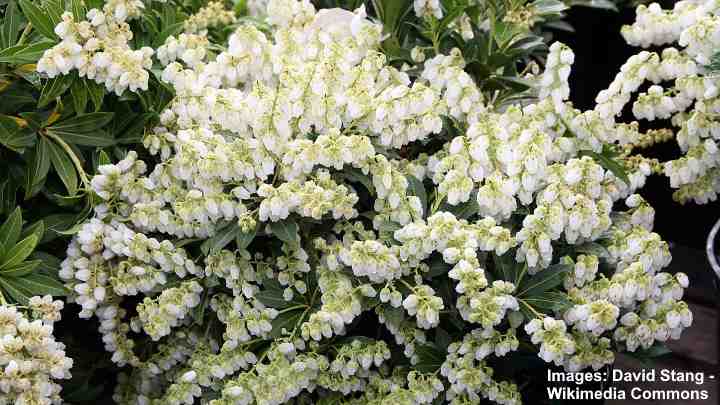
The low growing Pieris japonica 'Cavatine' looks beautiful in any foundation landscaping
The Pieris japonica 'Cavatine' is a flowering dwarf shrub with evergreen foliage. The 'Cavatine' plant is a foundation plant growing up to 2 ft. (0.6 m) tall. Creamy-white flowers add color that contrasts with the dark green foliage. Also called the lily-of-the-valley shrub, this is a low informal hedge plant.
Dwarf 'Cavatine' shrubs grow in full sun or partial shade in your front garden. The Japanese Pieris foundation plants are drought-tolerant and grow well in zones 6 – 8.
Rhododendron – Foundation Plants for Front Yards
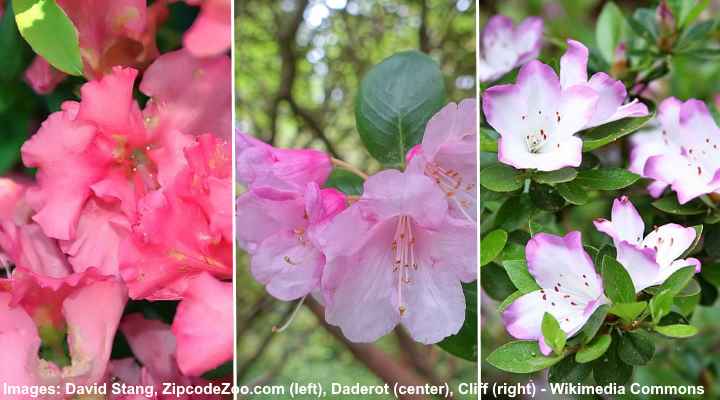
Evergreen cultivars of flowering dwarf Rhododendrons include: 'Hino Crimson' (left), 'Bow Bells' (center) and Dwarf Indica Azalea (right)
Rhododendrons are evergreen flowering shrubs for planting at the front of your house. Many rhododendron shrubs are ideal foundation plants as they grow to between 2 and 4 ft. (0.6 – 1.2 m) tall. Evergreen rhododendrons are excellent choices for full sun or partial shade around foundations. Rhododendron shrubs produce stunning flowers in spring.
Here are some of the best rhododendron shrubs for front yard foundation planting:
- Rhododendron 'April Rose'—This hardy semi-dwarf bush has large purple flowers, broad green leaves, and is extremely cold-hardy. This foundation plant grows 3 to 4 ft. (1 – 1.2 m) tall and thrives in zones 4 – 8.
- Rhododendron 'Dora Amateis'—This spectacular small shrub blooms with masses of white flowers every spring. The low-growing, bushy foundation plant grows in the sun and shade. Ideal for planting in front yards in zones 5 – 8.
- Rhododendron 'Hino Crimson'—The 'Hino Crimson' rhododendron is a stunning flowering shrub for your house's front yard. Only growing to 2 or 3 ft. (0.6 – 1 m) tall, the low bush has shiny evergreen foliage and showy dark pink flowers. Grow in zone 5 – 9.
- Rhododendron 'Bow Bells'—Beautiful clusters of pink scented flowers cover this small evergreen shrub when it blooms. Glossy, dark-green foliage retains its color throughout the winter.
- Dwarf Indica Azalea (Rhododendron eriocarpum)—Evergreen in most climates, this dwarf flowering shrub only grows to about 2 ft. (0.6 m) tall. Grow this rounded broadleaf bush in shrub borders, as a small flowering hedge, or an accent plant.
Discover the best small flowering shrubs.
Inkberry Foundation Plants (Ilex glabra)
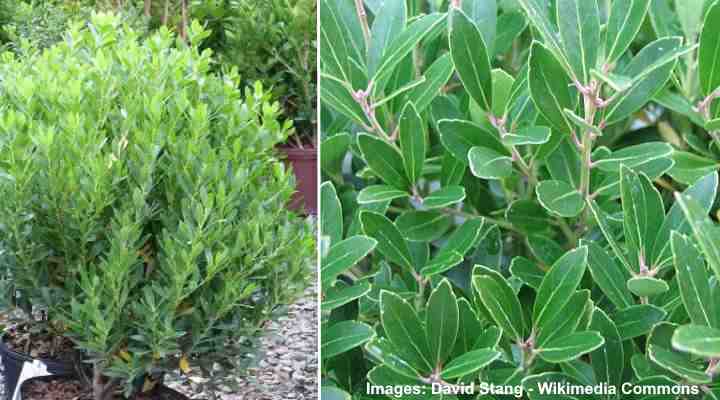
If you are looking for foundation planting ideas, Inkberry 'Shamrock' is a low maintenance small shrub for front of house
Inkberry shrubs such as the 'Shamrock' (Ilex glabra 'Shamrock') are perfect for foundation planting. Inkberries are evergreen shrubs that produce flowers in summer and black berries in the fall. The Inkberry 'Shamrock' cultivar has thick, dark green leaves for year-long color in your front yard. Inkberry 'Shamrock' plants grow to 3 or 4 ft. (1 – 1.2 m).
Inkberry shrubs grow just as well in full sun or partial shade. The bushy foundation plants grow in all types of soil and don't mind wet ground. These shrubby, low-growing, easy-care plants thrive in zones 4 – 9.
Here are some other inkberry foundation plants:
- Inkberry 'Strongbox'—This low-growing compact shrub has small leaves, thick foliage, and grows up to 3 ft. (1 m) tall.
- Inkberry 'Gem Box'—Looking like boxwood, the 'Gem Box' inkberry foundation plant has small dark green leaves, compact growth, and survives soggy soil and full sun.
Arborvitae Foundation Plants (Thuja)
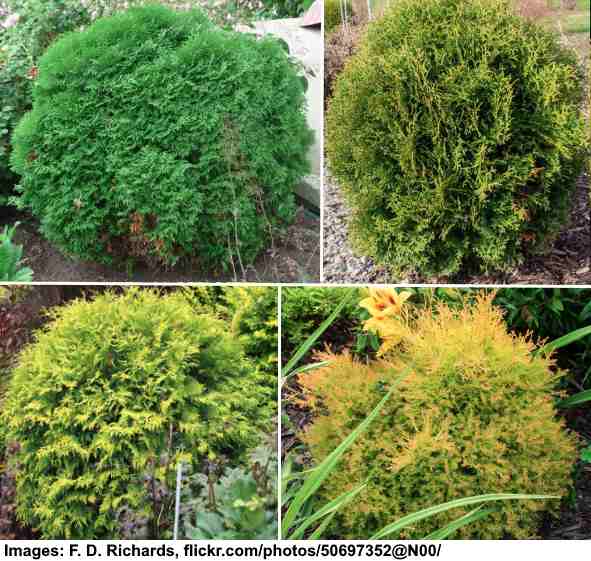
This picture shows dwarf arborvitae (thuja) cultivars, clockwise from top left: 'Little Giant', 'Hetz Midget', 'Fire Chief' ('Congabe') and 'Aurea Nana'
Dwarf arborvitae shrubs are excellent foundation plants with soft, evergreen foliage. Small varieties of arborvitaes grow best in full sun along the front of houses. Or you can grow taller upright, compact arborvitae trees as corner plantings or entrance plantings. Arborvitae shrubs grow in zones 3 – 7.
Here are some of the best arborvitae choices for growing around the foundation:
- Dwarf Golden Oriental Thuja (Platycladus orientalis 'Aurea Nana')—This dwarf evergreen shrub has golden-yellow foliage and soft needle leaves. Grow in sunny or partially shaded front yards to hide foundations.
- Thuja occidentalis 'Little Giant'—This conifer species is an excellent choice for foundation plantings. The arborvitae has a compact dome shape with soft green feathery foliage. Grow in sunny front yards around foundations.
- Thuja occidentalis 'Hetz Midget'— The pretty compact rounded shrub has a flattened top and soft conifer feathery leaves. Plant this easy care arborvitae along the front of your house as a foundation plant.
- Thuja occidentalis 'Fire Chief'— The short shrub has dense feathery foliage that is golden yellow in spring. It gradually turns green and red in the fall. This low-growing arborvitae is perfect for foundation plantings, low hedges, or borders. 'Fire Chief' arborvitae grows to 3 to 4 ft. (1 – 1.2 m) in zones 5 – 9.
Wintercreeper (Euonymus fortunei) Shrubs for Foundation Plantings
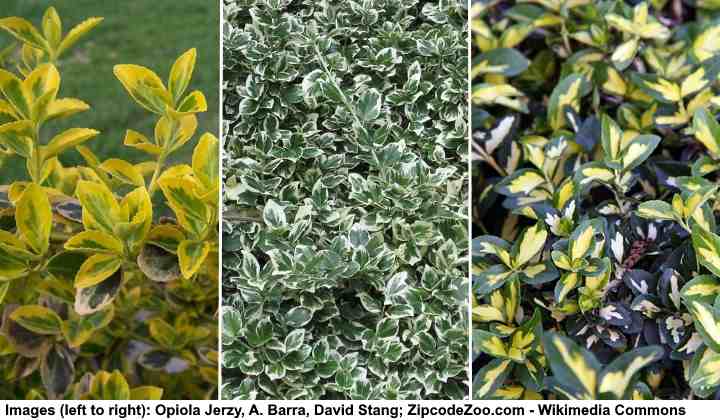
The colorful foliage of small evergreen Euonymus shrubs adds ornamental element to your front garden. This picture shows the compact cultivars: 'Emerald 'n' Gold', 'Emerald Gaiety' and 'Moonshadow'
Wintercreeper shrubs are foundation plants with golden yellow and green foliage. Wintercreeper cultivars grow to between 1 and 2 ft. (30 – 60 cm) and are ideal for hiding foundations, ground cover, edging, or garden borders. These cold-hardy, brightly-colored plants grow just as well in the shade as in full sun.
Wintercreeper shrubs grow in zones 5 – 9. Before planting them near your foundation, check with your state as they are considered invasive in some areas.
Here are some wintercreeper shrubs for foundation planting:
- Euonymus fortunei 'Emerald 'n' Gold'—This wintercreeper will brighten your front yard with its yellow and bright green foliage. Ideal for planting around foundations in shaded areas of your yard.
- Euonymus fortunei 'Moonshadow'—Lush green and yellow foliage provides stunning foundation cover in sunny or shaded front yards. 'Moonshadow' wintercreeper grows up to 3 ft. (1 m) tall with a 5 ft. (1.5 m) spread.
- Euonymus fortunei 'Emerald Gaiety'—White and green variegated foliage on this low-growing bushy evergreen shrub creates an excellent ground cover. Grow in sunny front yards as a foundation plant, low hedge, or to climb up walls.
Dwarf Spruce Shrubs for Front of House Planting
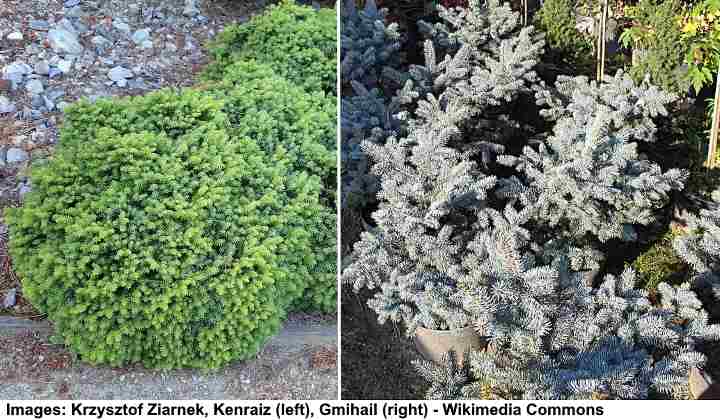
In this image: Picea abies 'Little Gem' (left) and Picea pungens 'Glauca Globosa' (right)
Dwarf spruce shrubs add plenty of curb appeal to your front yard. Spruce conifer shrubs are low-growing, evergreen plants that grow best in full sun. Their bluish-green colors, needle-like foliage, and spreading growth make them a perfect choice for foundation plants. Spruce shrubs and trees grow in zones 3 – 8.

The birds nest spruce (Picea abies 'Nidiformis') is a slow grower shrub with round shape and flat top
Here are some of the best spruce conifers for foundation planting:
- Bird's Nest Norway Spruce (Picea abies 'Nidiformis')—This foundation plant has an oval shape with a flattened top. The 'Bird's Nest' spruce has dense light green foliage. The low-growing conifer grows to 3 or 4 ft. (1 – 1.2 m) tall.
- Dwarf Norway Spruce (Picea abies 'Tompa')—The 'Tompa' spruce cultivar has a conical shape that doesn't grow higher than 3 ft. (1 m). Plant as a foundation plant or entrance plant in a sunny front yard.
- Dwarf Black Spruce (Picea marina 'Nana')—The dwarf spruce shrub is a cute round foundation plant that only grows 2 ft. (60 cm) tall.
- Dwarf Alberta Spruce (Picea glauca 'Conica')—This foundation conifer plant has a pyramid shape. Its light green foliage and ornamental look make it ideal for landscaping at corners, as entrance plantings, or to add a visual accent to other foundation plants.
- Picea abies 'Little Gem' – A dwarf evergreen spruce shrub with needle-like dense foliage and flattened round shape. This compact shrub will look great in a rock garden or in front of other taller shrubs.
- Picea pungens 'Glauca Globosa'—Pictures of this miniature spruce show a globe-shaped, blue-needled shrub. The slow-growing dwarf evergreen will eventually reach about 3 or 4 ft. (1 – 1.2 m) tall.
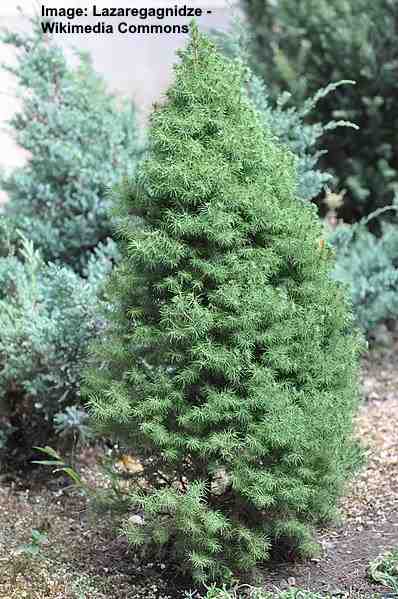
Picea glauca 'Conica' (dwarf Alberta spruce)
Hydrangea – Flowering Foundation Shrubs

Bigleaf Hydrangea or Mophead Hydrangea (Hydrangea macrophylla)
Hydrangeas are deciduous ornamental foundation shrubs with a rounded shape and clusters of large globular flowers. Hydrangeas are popular flowering landscaping plants for front of house due to their low-maintenance requirements and their showy flower clusters during summer.
Most hydrangeas are large flowering shrubs that grow between 3 and 5 ft. (1 – 1.5 m) high. Several species of hydrangea have a compact, short growth that makes them ideal flowers for small gardens and the front yard.
Hydrangea are easy care landscaping shrubs that have average water needs, and are not fussy about the soil. Hydrangea shrubs grow best in partial shade, however, some hydrangea flowers flourish in full sun. The only care these shrubs need is pruning spent flowers.
The beautiful hydrangea flowers bloom for many weeks in the summer and grow as clusters of flowers in shades of blue, lavender, white, pink, red, green, and purple.
Plant an easy-care small variety of hydrangea shrubs in front of the house, as an accent flowering plant, or grow in a row to create a colorful hedge. As a bonus, the beautiful large flowers look stunning in cut flower floral displays.
Most hydrangea cultivars thrive in USDA zones 3 – 9.
Here are some of the best hydrangea shrubs for front yard foundation planting:
- Hydrangea macrophylla 'Nikko Blue' – This is one of the most popular mophead hydrangea shrubs for foundation planting. Flowers are blue in acidic soils and develop pink hues in alkaline soils. This ornamental hydrangea plant grows to 4 – 6 ft. (1.2 – 1.8 m) tall and wide.
- Hydrangea macrophylla 'Endless Summer Bloomstruck' – a hardy mophead hydrangea variety with attractive rounded growth habit and two-toned lilac or pink flowers. It grows to 3 – 4 ft. (1 – 1.2 m) tall and up to 5 ft. (1.5 m) wide.
- Hydrangea paniculata 'Little Lime' – This is a compact dwarf shrub for front of house that doesn't grow higher than 5 ft. (1.5 m). This hydrangea produces lime-green flowers, large pointed green leaves, and has round, mounding growth.
- Hydrangea arborescens 'Annabelle' – This front of house plant has spectacular huge showy white flowers. 'Annabelle' hydrangea has a compact, rounded growth habit, making it ideal for foundation planting. This easy care landscaping shrub grows to 3 – 5 ft. (1 – 1.5 m) tall and 4 – 6 ft. (1.2 – 1.8 m) wide.
- Mountain Hydrangea (Hydrangea serrata) – This is one of the smaller varieties of hydrangea with showy light pink or light blue flowers and lush green foliage. Ideal for growing in front of the house, or as a colorful shrub border. It grows to 2 – 4 ft. (0.6 – 1.2 m) tall and wide.
Foundation Trees for Corner House Plantings
Upright conical evergreen trees and shrubs such as arborvitae, spruces, boxwood, and yews are excellent choices for planting at house corners. Columnar trees can frame the front of your house and accent your other foundation plants. Ideally, corner plants should be small or dwarf trees that are attractive throughout the year.
When planting trees at the corner of your house, ensure they are not too close to the building. As trees grow and mature, they spread out. So, they shouldn't conceal your house's corners, but they should accent its architectural features.
Here are some excellent choices for trees to grow near the corner of your house.
American Arborvitae 'Smaragd' (Thuja occidentalis 'Smaragd')
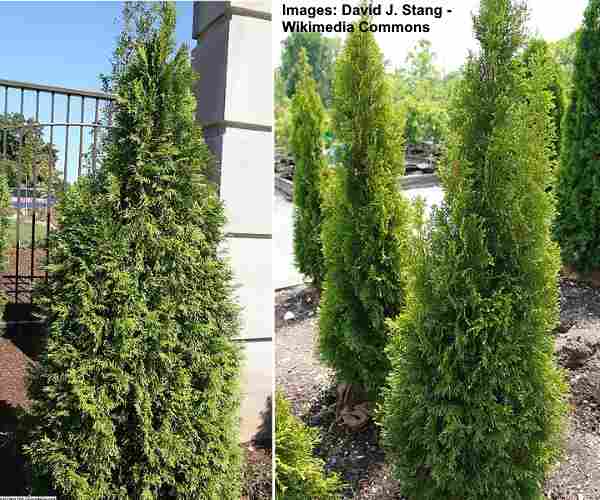
American arborvitae 'Smaragd' is a small tree that is suitable to accents the entrance or corner of the house
The Smaragd arborvitae is a columnar tree that gives visual appeal to the corners of your house. These narrow arborvitae semi-dwarf trees have light green, feather foliage. Slow-growing and easy to grow, the 'Smaragd' reaches heights up to 14 ft. (4.2 m) tall.
Also called 'Emerald Green' arborvitae, you can grow Smaragd evergreen conifer trees in containers at your entrance.
Upright Japanese Plum Yew (Cephalotaxus harringtonia 'Fastigiata')
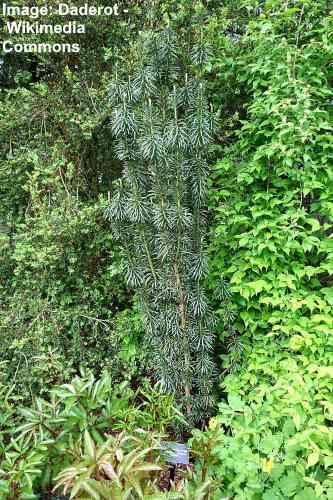
Upright Japanese plum yew is a beautiful small columnar tree for landscaping the corner of the house
The Upright Japanese Plum Yew is a skinny compact evergreen tree, ideal for planting at the corners of your house. This evergreen yew grows to 8 or 10 ft. (2.4 – 3 m), has erect upward growing stems, and blackish-green leaves. Plant in sunny or partially shaded gardens to give visual appeal to the edges of your house.
Redbud (Cercis) Tree
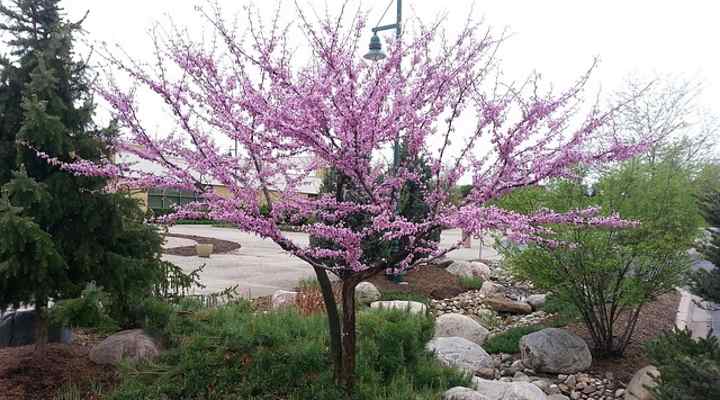
Redbud is a small low maintenance flowering tree for the front of house
Redbuds are small ornamental flowering trees with pink flowers that you can plant near the corner of your home. Redbuds turn a stunning rosy-pink color when they bloom in spring. Lush, heart-shaped leaves cover the tree in summer and fall. Although redbuds are deciduous trees, their intricate stems and branch patterns provide a fascinating winter silhouette.
Discover the best flowering plants for the front yard.
Related articles:
- Small Trees for Landscaping Small Spaces
- Small or Dwarf Weeping Trees for Landscaping
- 18 Different Types of Shrubs to Grow in The Yard
Read Next
House Front Yard Design Pictures
Source: https://leafyplace.com/foundation-plants/


0 Response to "House Front Yard Design Pictures"
Post a Comment